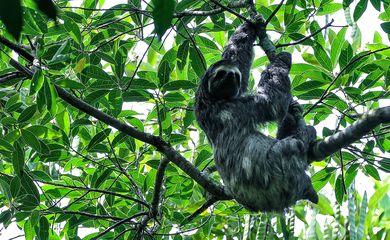Researchers find nearly extinct bird missing for 40 years

It was 4 a.m. in the floodplain of the river that bathes the Mãe Maria indigenous land, in the municipality of Bom Jesus do Tocantins, in the state of Pará. The birdsong came as a surprise to two ornithological researchers, on the tenth day of their expedition in search of the critically endangered mutum-pinima bird. They could hardly believe their ears, and then what they saw. No researcher had seen the bird up close for 40 years. And it happened.

"We watched and recorded six birds for more than ten minutes. It was such a joy," says ornithologist Gustavo Gonsioroski, who worked on the study carried out in October. Among the six specimens there were couples, which guarantees the hope of maintaining the species.
Gonsioroski, along with other researchers, plans to return to the region in December to locate more mutum-pinima birds for further management and protection efforts. This initiative is part of the Territorial Action Plan for the Conservation of Endangered Species in the Mid-North Territory (PAT Meio Norte), under the Pro-Species: Everyone against extinction project, run by the Ministry of the Environment and Climate Change.
“Locating six specimens of the mutum-pinima bird was an unprecedented achievement, evoking a surge of adrenaline and emotion," shared Gonsioroski. The researchers depended on insights from indigenous people in the region, particularly the Gavião Parkatejê ethnic group. Additionally, they utilized technology, employing ten audio recorders and ten trap cameras for video recording.
Threats
Biologist and ornithologist Leonardo Victor, a participant in the expedition, revealed that the identification occurred just as they were on the verge of giving up. "We strategically positioned the cameras based on recommendations from indigenous people. Initially, we were taken aback; the species hadn't been sighted for 40 years."
The researchers explain that this bird species is confined to a limited region of the Amazon, situated between the eastern banks of the Tocantins River and the Maranhão Amazon. Gustavo Gonsioroski highlights, "The primary challenge for the species lies in its confinement to a region of the Amazon's floodplain forest, which has suffered extensive devastation due to deforestation."
Raising awareness
Besides habitat destruction, Victor elaborates that bird hunting in the region is culturally ingrained. The researchers assert that the presence of the bird in this area suggests that indigenous land remains a relatively protected space.
Laís Morais Rêgo, the coordinator of the action plan, emphasizes that the discovery should be coupled with efforts to reinforce legislation for the protection of this endangered species.
Rêgo clarifies that the plan she oversees has the objective of safeguarding 12 critically endangered species and enhancing their conservation status. The critical endangerment stage is a precursor to extinction. Another aim of the project, she emphasizes, is to cultivate awareness within the local communities to actively contribute to the protection of these animals.
"The indigenous people were deeply moved by the bird's predicament and willingly stepped forward to assist in conveying the message that hunting should be avoided," explains biologist Leonardo Victor. The researchers estimate that no more than 50 of these birds are alive in the wild, and remarkably, they encountered six of them within a span of ten days.
Açaí planters
Preserving a species holds immeasurable significance for the environment. Nevertheless, the researchers underscore the importance of emphasizing, particularly to the general public, that a species like the mutum-pinima plays a fundamental role in human life. Leonardo Victor noted, "I strive to communicate that the bird is a natural provider of ecological services."
"It's insufficient to merely acknowledge the legislative aspect of natural heritage. It's crucial to recognize that this bird contributes to preserve açaí plantations in the region. This endangered species plays a vital role by dispersing seeds that cultivate the açaí forest in the Amazon, thereby sustaining the livelihoods of local communities," explains Gonsioroski.
The research coordinator underscores the educational significance of the interconnected relationship between fauna and flora, particularly the role of birds near rivers in açaí plantations. "It's a vital component in the system. If one species ceases to exist, others will also begin to disappear."
In December, the research team will revisit the region to retrieve the recorders and cameras, extending their search to new locations. Their quest for the elusive bird with a distinctive song, challenging to capture even with a recorder due to its shy and elusive nature, persists. The bird emerges in the morning, vanishes during the day, and reappears at dusk. Researchers aim to unravel this narrative, gaining insights to better understand and preserve this species.



